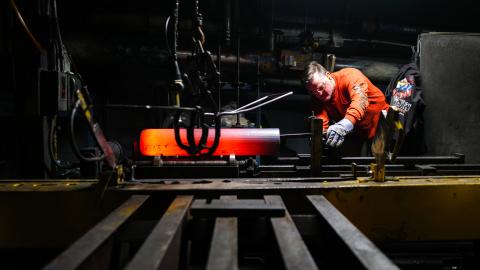The economy grew in the first quarter at "point one percent," announced Mitch McConnell, and then repeated it by way of introduction to an attack on President Obama's economic policies. Whether seeming to revel in the misery of a slow recovery that has kept unemployment high and wages low simply because it drives the president's approval rating down is good politics I leave to politicians, "that insidious and crafty animal, vulgarly called a ... politician, whose councils are directed by the momentary fluctuation of affairs," as Adam Smith put it.
But it certainly is bad economics. It is foolish to plant one's feet in the quicksand of one data point, Smith's "momentary fluctuation"--unless one is prepared to congratulate Obama if the predicted spring rebound occurs as consumers make up for snow-bound time, as they seem to be doing.
A good number of economists are guessing that severe winter weather during the first quarter chopped 1.5 percent off that period's GDP, one of the accurate statements made by Obama's press secretary in recent weeks. Consumers couldn't get to the shops, exports couldn't get to ports or on the road to Mexico and Canada, two of America's largest foreign markets. The Federal Reserve Board's monetary policy gurus remain optimistic that "growth in economic activity has picked up recently," an optimism supported by a slew of recent data.
* The manufacturing sector expanded in April for the eleventh consecutive month.
* Production, employment, and new orders in the Chicago area rose in April, a move, says Goldman Sachs, "consistent with brighter Philly, Richmond, and Dallas" regional results.
* Personal incomes rose more than expected in March, led by wage and salary income.
* Personal spending chalked up a solid gain since the end of the first quarter.
* Exports have recovered from their Q1 collapse.
* Orders for durable goods such as cars and fridges rose by 2.6 percent in March, the largest increase in six months, and car sales in April topped the winter months.
* Consumer confidence remains close to a six-year high despite a slight dip in April.
If winter comes ... well, you know the rest.
Perhaps most significant, real investors who put real money behind guesses as to the future of the economy discounted the poor Q1 report, and drove share prices to the first record-close of the year on the very day that the poor first-quarter GDP data were announced. Markets are far from an infallible guide to future economic activity, but then again neither are economic forecasts.
As is often the case, not all data point in one direction. In an interview prior to the annual meeting of his Berkshire Hathaway group, the fabled investor Warren Buffett pointed out that the housing sector is "not that strong. ... The pickup is lower than I had anticipated." Which is one reason some economists expect the recovery to remain feeble, with the economy growing at a rate of only some 2.3 percent, which compares with the 4.1 percent average for all post-1960 recoveries.
The nil first quarter growth triggered a new round of the blame game, with winter weather only one of the perceived villains of the piece. Too-tight fiscal policy, too-high taxes such as those driving Pfizer to lower-tax Britain, too-pervasive regulation, and Obamacare are among the accused. To which Alan Greenspan, former chairman of the Federal Reserve Board, adds: uncertainty. He notes that businesses are spending on short-lived assets such as software, but not on long-lived assets such as plant and equipment.
Yesterday a new jobs report provided ammunition to all parties to the debate on the near-term future of the American economy. In April the economy added 288,000 jobs, 273,000 of them in the private sector, with the gains spread widely among industries. The unemployment rate fell from 6.7 percent in March to 6.3 percent. Cheers from the optimists and from all the president's men.
More important, respond the pessimists, are three facts lurking beneath the headline job-growth numbers: the fall in the labor-force participation rate, the plight of the long-term unemployed, and the poor quality of the jobs being created.
A good part of the decline in the unemployment rate is due to the decision by millions of workers to drop out of the labor force. If the labor force participation rate had not deteriorated since late 2008, the unemployment rate would be close to 11 percent. Worse still: about half of those dropping out of the labor force are in their prime working years, rather than retirees. This means that most of the so-called improvement in the labor market has been due to reduced availability of workers rather than to an increase in the demand for them. Call it a jobless recovery.
Equally worrying is that 3.5 million workers remain out of work for longer than 27 weeks. Conservatives are pointing to an April decline in that figure as proof that congress' decision not to extend unemployment benefits at the end of 2013 is driving the long-term unemployed back into the work force, and that the majority of the long-term unemployed will find jobs if the economy would only grow faster. Others are not so sure that the dropouts represent a vast reserve army of the unemployed eager and able to re-enter the labor market (and in the process restraint wage increases and inflation). They say that these workers are too unskilled or deskilled ever to hold the sort of jobs being created in the modern American economy, witness complaints from employers who cannot fill openings for welders (salary: $100,000 per year) and similarly skilled workers.
Which brings us to the quality of the jobs being created. To summarize a huge data trove: more high-paying jobs are being lost than are being created, while the number of low-paying jobs is increasing. Meet your recent graduate, the hamburger flipper. An exaggeration, and ignores the fact that entry-level jobs often lead to better ones, but a worry nevertheless, especially for a graduating class that has been lured into indebtedness by feckless government policies.
My own guess is that the growth rate will accelerate to at least 3.5 percent, and that the unemployment rate will continue to drop. But this will not solve the problems of low labor-force participation and the skills shortage. More rapid growth and a lower unemployment rate will leave the Fed in what former Fed governor Larry Lindsey calls "the unenviable position" of having to raise interest rates before the market does it for them, even while its chair, Janet Yellen, remains unhappy with the condition of the labor market.
















